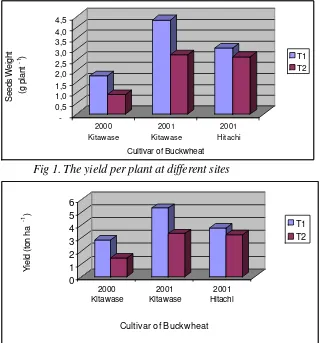BUCKWHEAT PLANT RESPONSE TO TROPICAL ENVIRONMENT OF WEST JAVA, INDONESIA
Yonny Koesmaryono1), Suman Sangadji2), Taufan Hidayat1), Perdinan1), Irman1) and Hideki Sugimoto3)
1) Bogor Agricultural University, Bogor, Indonesia 2) Darussalam University, Ambon, Indonesia
3) Ehime University, Matsuyama, Japan
ABSTRACT
Buckwheat produces high carbohydrate and it can be used as complement and healthy food. The plant is grouped as a subtropical crops but based on preliminary experiment it can be grown well at upland plain in tropical region of Indonesia, which has cooler air temperature. Air temperature is one of the most important factors that influence the growth of buckwheat which related to sowing date and the site of planting. An attempt has been done to study the response of buckwheat plant to tropical climate in West Java, Indonesia.
The experiment was done in two years, in 2000, two sites have been chosen which are located at 1150 m (T1) and 500 m (T2) above sea level, respectively. A cultivar
of kitawasesoba was grown at three population densities, viz 130, 160 and 200 plants m
-2
. Then, the experiment in 2001 has been planted two cultivars of kitawasesoba and hitachi-akisoba at two population densities, viz 100 and 150 plants m-2. The plant growth were observed weekly and yield were sampled at harvesting. Whilst, thermal unit were calculated through the growing season till harvest, the photosynthetic rate at stage of full canopy has been measured at the experiment in 2000.
Difference in elevation caused adiabatical process, the higher the place above sea level was the cooler the air temperature. Climatic parameters along research period are shown at Table 1.
Table 1. Climatic parameters of sites along research period in 2000
Air Temperature (oC) Sites
Max Min Avg
Rainfall (mm)
Daily Wind Velocity
(ms-1)
Total Radiation (cal cm-2)
Daily Radiation (cal cm-2)
T1 (1150 m)
25.0 16.6 20.5 254.0 3.99 16 641 300.7
T2 (500 m)
27.2 20.3 23.7 114.4 2.57 19 237 430.9
The experiment results indicated that growth and yield of buckwheat plant were great influenced by climatic difference between two sites. At T1 the buckwheat plant
and 901 degree days for Hitachi-akisoba. While at T2, the plant matured at 849 – 914
degree days for kitawasesoba and 975 degree days for hitachi-akisoba. The harvest period at T1 was took about 55 days, while that of T2 was only about 45 – 50 days. The
photosynthetic rate has been measured at level of 20 µmol CO2 m-2 s-1 and 12 CO2 m-2 s -1
for exposed leaf to sunlight at T1 and T2, respectively.
As consequences of climatic difference, the results revealed that the cooler the site was, the higher the growth, dry matter production and yield (Fig 1 and Fig 2).The highest average yield per hectare in the first year was reached at T1 , those were 2.849
ton ha-1 ,while at the lower place (T2) the average yield just reached 1.466 ton ha-1. The
experiment in second year showed the same result that T1 gave the highest average
yield, those were 5.320 ton ha-1 for kitawasesoba and 3.766 ton ha-1 for Hitachi-akisoba. While at the lower place (T2) the average yield were 3.345 ton ha-1 for kitawasesoba and
[image:2.596.98.418.308.651.2]3.260 ton ha-1 for Hitachi-akisoba.
Fig 1. The yield per plant at different sites
Fig 2. The yield per land unit at different sites
-0,5 1,0 1,5 2,0 2,5 3,0 3,5 4,0 4,5
Seeds Weight (g plant
-1 )
2000 Kitawase
2001 Kitawase
2001 Hitachi
Cultivar of Buckwheat
T1 T2
0 1 2 3 4 5 6
Yield (ton ha
-1 )
2000 Kitawase
2001 Kitawase
2001 Hitachi
Cultivar of Buckwheat
